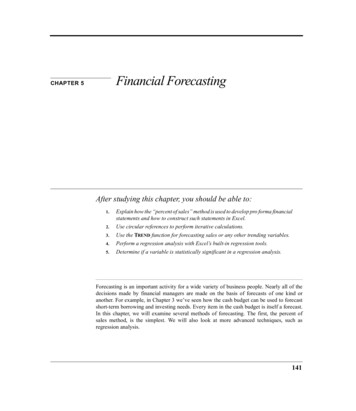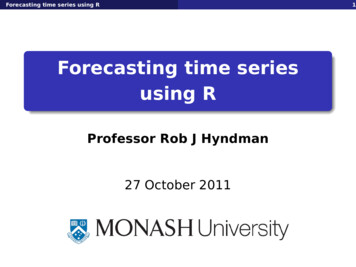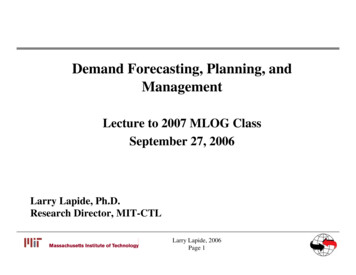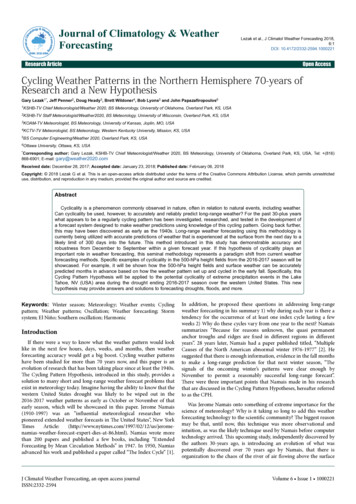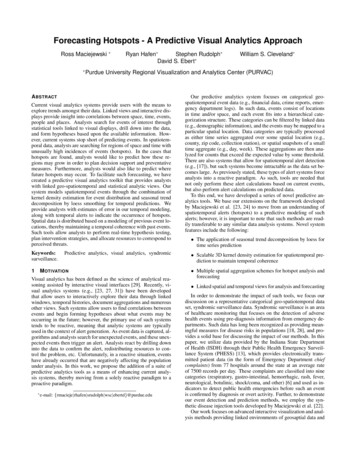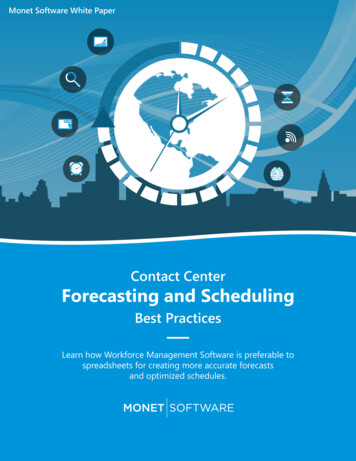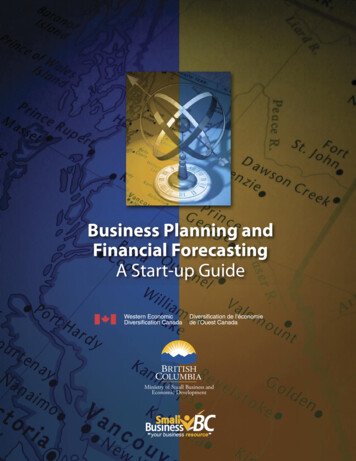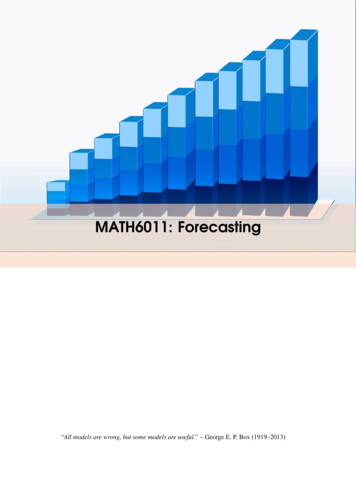
Transcription
iMATH6011: Forecasting“All models are wrong, but some models are useful.” – George E. P. Box (1919–2013)
About the courseAs stated in the module profile, the aim of this course is to (1) introduce the students to timeseries models and associated forecasting methods; (2) show how such models and methods can beimplemented on a spreadsheet to analyse time series data; (3) give an appreciation of the differentfields of application of time series analysis and forecasting; and (4) convey the value of suchquantitatively based methods for solving realistic practical problems. Students who completethe module successfully should be able to (a) formulate time series models and construct Excelspreadsheet-based versions; (b) use spreadsheet techniques to fit and analyse such models to data;(c) appreciate both the capabilities and the limitations of such computer based techniques; and (d)produce well-structured assignment reports describing problem formulation and solution.There is no pre-requisite for the module, but students who have taken MATH6147 (Spreadsheetand Database Modelling) and MATH6005 (Visual Basic for Applications) will find the Excelimplementations of the models relatively easy. The material for these modules will be madeavailable on the Blackboard site of this course. This will allow those of you who are interested tolook at them for further details on Excel (MATH6147) or VBA (MATH6005) to go through themand possibly learn how to develop their own VBA codes for the algorithms that will be discussedin the course. Further links and sites for quick references on these tools are also provided on theblackboard site. Note however that for this course and the related assessment, no programmingskill is required and all the basic tools needed to succeed are provided. It might also be useful tomention that it would be an advantage to have taken a basic course on statistics. Most of the usefulconcepts will be recalled, and further details can be found in any basic book on Statistics, see, e.g.,Clarke, G.M. and Cooke, D. 2004, A basic course in statistics, 5th Ed., Wiley.The module uses Makridakis, S., Wheelwright, S.C. and Hyndman, R.J. 1998, Forecasting:Methods and Applications 3rd Ed., New York: Wiley as text book. Most of the material of thesenotes is extracted from there. Also, most of the data sets used in the demonstrations is drawn fromthis book. (The full set from the book can also be downloaded under Course Documents, if desired.)Hyndman, R.J. and Athanasopoulos, G. 2014. Forecasting: principles and practice. Ortexts.comhas recently superseded the latter book. Hence, some of the material of these notes has also beendrawn from there. An additional advantage of the book by Hyndman and Athanasopoulos (2014) is
ivthat it is freely accessible to read online (at https://www.otexts.org/fpp/). A few hard copies of thebook can be found at the Hartley Library. Other interesting references include:1. Anderson, R.A., Sweeney, D.J. and Williams, T.A. 1994. An Introduction to ManagementScience. 7th Edn, West Publishing Co.;2. Draper, N.R. and Smith, H. 1981. Applied Regression Analysis, 2nd Ed. New York: Wiley;3. Gilchrist, W.G. 1976. Statistical Forecasting, New York: Wiley;4. Janert, P.K. 2011. Data Analysis with Open Source Tools. Sebastopol: O’Reilly;5. Wetherill, G.B. 1981. Intermediate Statistical Methods. London: Chapman and Hall.All notes and spreadsheets used in the module are available on the course Blackboard site underCourse Documents, where the spreadsheets are grouped by chapter and workshop, respectively.The notes are meant to be worked through and each chapter is accompanied by a number ofdemos associated to the spreadsheets, illustrating the topic or method being discussed. They arean essential part of the text and must be carefully studied, possibly before the lectures. In thespreadsheets, the following convention for cells is used: Cells with a Yellow background - Headings, incidental Information; Cells with a Green background - Input information used in calculations on that sheet; Cells with a Blue background - Calculations and results that you should be producing.Exercises included at the end of each chapter correspond to the worksheet for the workshop ofthe corresponding week. They will be worked through during the workshops (computer labs) thatfollow the Friday lecture. The workshop exercises follow the same patterns as the demos, and usethe same data sets in some cases, in order to give you the opportunity to get more familiar with therelated material, as focus at lectures will be more on the mathematical aspects of the models.Assessment: The assessment of the module is 100% by a single coursework assignment. Youwill be given the assignment and related instructions in the second week. Further details on thesubmission and other key dates of the module activities are given in the table on the next page.Feedback: A key opportunity to get feedback on your progress in the module will be during theweekly workshops. To benefit the most from the workshops, you are strongly encouraged to workon the problem sheets in advance before coming to the workshop. This will help us access whereyou are struggling and provide immediate help. It is also the best way for you to get well preparedfor the exercises in your coursework assignment. You are also encouraged to come to my officehours to discuss any particular aspect of the lectures/material you might be struggling to understand.No appointment is needed to come to my office hour. I will be able to provide some brief elementof feedback by email (efforts will be made to reply by the next working day after reception) if youhave any quick questions. I have also arranged three voluntary sessions (assignment surgeries),prior to the coursework submission deadline, where you could ask questions and get feedback onthe module and the coursework preparations; see next page for the dates. The final feedback onyour performance on the coursework will be provided within 4 weeks after the submission deadline.Acknowledgements: Dr Honora Smith and Prof Russell Cheng are gratefully acknowledgedfor the development of previous drafts of the course notes and the related material.InstructorDr Alain ZemkohoSchool of MathematicsBuilding 54, Room 10027a.b.zemkoho@soton.ac.ukPhD Teaching Assistantsa : Zulkipli HafizahBinti, Fulin Xie and Yuan Zhanga Theywill join me during the workshops to helpwith your questions on the exercises. Please do notcontact them for any assistance related to the coursework assignment.
v
Contents1Introduction and basic tools . . . . . . . . . . . . . . . . . . . . . . . . . . . . . . . . . . . . 11.1Graphical and numerical summaries1.1.11.1.2Graphical summaries . . . . . . . . . . . . . . . . . . . . . . . . . . . . . . . . . . . . . . . . . . . . . . 2Numerical data summaries . . . . . . . . . . . . . . . . . . . . . . . . . . . . . . . . . . . . . . . . . 31.2Decomposition1.2.11.2.21.2.31.2.4Trend estimation using moving averagesAdditive decomposition . . . . . . . . . . . . .Multiplicative decomposition . . . . . . . . .Decomposition and forecasting . . . . . . .1.3Data preparation1.3.11.3.21.3.31.3.4Length of the times series . .Missing and erroneous dataTransformations . . . . . . . . . .Calendar adjustments . . . . .1.4Exercises2Basic forecasting methods . . . . . . . . . . . . . . . . . . . . . . . . . . . . . . . . . . . . 112.1Accuracy analysis2.1.12.1.22.1.3Measures of Accuracy . . . . . . . . . . . . . . . . . . . . . . . . . . . . . . . . . . . . . . . . . . . . 11ACF of forecast error . . . . . . . . . . . . . . . . . . . . . . . . . . . . . . . . . . . . . . . . . . . . . 13Prediction interval . . . . . . . . . . . . . . . . . . . . . . . . . . . . . . . . . . . . . . . . . . . . . . . 132.2Averaging methods132.3Exponential smoothing methods142.3.12.3.22.3.3Single exponential smoothing . . . . . . . . . . . . . . . . . . . . . . . . . . . . . . . . . . . . . . 14Holt’s linear exponential smoothing . . . . . . . . . . . . . . . . . . . . . . . . . . . . . . . . . 14Holt-Winter’s method . . . . . . . . . . . . . . . . . . . . . . . . . . . . . . . . . . . . . . . . . . . . . 1524.56677.7889911
viii2.3.4Excel implementation of the exponential smoothing method . . . . . . . . . . . . . 172.4Exercises3Forecasting using regression . . . . . . . . . . . . . . . . . . . . . . . . . . . . . . . . . . 193.1The model and key statistics3.1.13.1.23.1.3Model description . . . . . . . . . . . . . . . . . . . . . . . . . . . . . . . . . . . . . . . . . . . . . . . 20Computing the coefficients of the regression model . . . . . . . . . . . . . . . . . . . . 21Key statistics for model evaluation . . . . . . . . . . . . . . . . . . . . . . . . . . . . . . . . . . . 223.2Selection of explanatory variables3.2.13.2.23.2.3Adding variables to the initial model . . . . . . . . . . . . . . . . . . . . . . . . . . . . . . . . . 24Time related explanatory variables . . . . . . . . . . . . . . . . . . . . . . . . . . . . . . . . . . 25Subset selection . . . . . . . . . . . . . . . . . . . . . . . . . . . . . . . . . . . . . . . . . . . . . . . . . 253.3Multiple linear regression for forecasting3.3.13.3.23.3.3Assumptions made and the validity of tests and forecasts . . . . . . . . . . . . . . . . 26Multicollinearity . . . . . . . . . . . . . . . . . . . . . . . . . . . . . . . . . . . . . . . . . . . . . . . . . 27Using Regression.xlsm to forecast . . . . . . . . . . . . . . . . . . . . . . . . . . . . . . . . . . . 273.4Exercises4The ARIMA method . . . . . . . . . . . . . . . . . . . . . . . . . . . . . . . . . . . . . . . . . . . 314.1Preliminary analysis4.1.14.1.24.1.3The partial autocorrelation function . . . . . . . . . . . . . . . . . . . . . . . . . . . . . . . . . 31A white noise model . . . . . . . . . . . . . . . . . . . . . . . . . . . . . . . . . . . . . . . . . . . . . 32Stationarity . . . . . . . . . . . . . . . . . . . . . . . . . . . . . . . . . . . . . . . . . . . . . . . . . . . . . 324.2ARIMA models4.2.14.2.24.2.34.2.4Autoregression (AR) models . . . .Moving Average (MA) models . .ARIMA (p, d, q) models . . . . . . .ARIMA(p, d, q)(P, D, Q)s models4.3Model selection and forecasting4.3.14.3.24.3.34.3.4Phase 1: Identification . . . . . . . . . . . . . . . . . .Phase 2: Parameters estimation and testing .Phase 3: Forecasting using the ARIMA modelUsing ARIMA.xlsm to forecast . . . . . . . . . . . . .4.4Exercises18202426283135.3636373738.3839404142
1. Introduction and basic toolsMany companies make use of judgmental forecasting techniques which rely on the knowledge ofexperienced employees and managers. Such a qualitative approach is common in the case wherethere is no historical data; for example, if one wants to forecast the sales of a new product. A typicalsituation where judgemental forecasting can also be crucial is Brexit. As there is no precedent tothis situation, it is almost impossible to accurately identify any historical factor that can be usedto make reliable predictions of its impact on the UK’s economy. Often, qualitative forecastingis carried out within the framework of fairly formal and regularly scheduled meetings. It can beaugmented by the kind of quantitative techniques discussed in this unit, and this combined approachhas much to commend it. Further details on qualitative forecasting methods can be found in Chapter3 of the book by Hyndman and Athanasopoulos (2014).Our focus in this course will be on quantitative forecasting methods. A quantitative approachrelies on sufficient reliable quantitative information being available. An explanatory model isone that attempts to explain the relationship between the variable to be forecast and a number ofindependent variables, e.g., the Gross National Product (GNP) of a country can be obtained asGNP f (monetary and tax policies, inflation, capital spending, imports, exports) Error,where f stands for “function of”.A black-box model is one that simply tries to relate future values of the variable of interest toprevious values, without attempting to explain its behaviour in terms of other variables. A timeseries model is one that attempts to relate the value of a variable(s) at one time point with values ofthe variable(s) at previous time points, for example,GNPt 1 f (GNPt , GNPt 1 , GNPt 2 , . . .) Error.Here, t denotes the time. Thus “simple” time series models, like the one above, are “black-box”.More complex time series models are explanatory in that they try to relate the value of the variableof interest not simply with its previous values but also with previous values of other “explanatory”variables.
Chapter 1. Introduction and basic tools2This module will be concerned with such simple time series models, as well as some explanatory modelling (see chapter on regression). The methods that we will discuss are all based onextrapolation into the future of patterns shown in the past. Confidence in such forecasts is thereforebased on confidence that such patterns will, in future, remain stable.We begin with the preliminaries to forecasting that enable you to begin to find the best forecasting model to use with a particular time series. Before we start with the basic tools that we will beusing in the course, let us recall that our focus will mostly be on two types of data (time series dataand cross-sectional data) that we are now going to formally define.Definition 1.0.1 Time series data are data from a unit (or a group of units) observed in severalsuccessive periods, whereas cross-sectional data are data from units observed at the same timeor in the same time period. The latter may be single observations from a sample survey or fromall units in a population.Though our main focus here will be on the first type, the second will also be of a great use,especially in Chapter 3. Examples of time series are discussed in Demo 1.1 while an example ofcross-sectional dataset is given in Demo 1.3.1.1Graphical and numerical summariesThis course is a practical introduction to the skills of forecasting. To give experience in encountering a variety of time series, real-life datasets are used, both during the course and for the finalcoursework.1.1.1Graphical summariesTime plotsThe essence of forecasting models is that patterns are projected forward in time, while randomeffects are discarded. The first thing to do when forecasting is therefore to make a time plot andlook for patterns. The following may be observed: A trend, which is a long term increase or decrease in the variable of interest. A seasonal/periodic pattern appears when a time series is affected by seasonal factors suchas time of the year or the day of the week. A cyclical pattern, which is one where there are rises and falls but not of regular period,generally thought of as longer in time, e.g., several years.It should be noted that combinations of the above three types of pattern occur frequently. We willtreat trend and cycles together in the following analysis, and will often refer to trend-cycles.A time series is said to be stationary if the distribution of the fluctuations is not time dependent.In particular both the variability about the mean, as well as the mean must be independent of time.A stationary time series therefore has no trend, cycle or seasonality and no patterns that can be usedfor forecasting.Demo 1.1: Using the data sets from the Chapter 1 data folder on Blackboard, make time plotsfor the corresponding series: Australian monthly electricity (TimePlotTransformElec.xls), UStreasury bills (TimePlotUstreas.xls), Australian clay brick (TimePlotBricks.xls). The first example, Australian monthly electricity production, displays a clear trend andseasonality. Note that both the seasonal variability as well as the mean show a trend. The US treasury bill contracts data shows a trend, but there is less certainty as to whetherthis trend will continue. The data on Australian clay brick production contains occasional large fluctuations whichare difficult to explain, and hence predict, without knowing the underlying causes.
1.1 Graphical and numerical summaries3Seasonal plotsIf an initial inspection of a time plot leads you to suspect that seasonality may exists, then severalmethods exist to demonstrate and to give evidence for its existence. A seasonal plot is one wherethe time series is cut into regular periods and the time plots of each period are overlaid on top ofone another. It is an effective means of demonstrating seasonality, for example to a client who isnot overly technically minded.Demo 1.2: Produce the time and seasonal plots for the Australian beer production data provided inthe file with name TimeSeasonalPlotBeer.xls.If seasonal plots lead you to think that seasonality may exist, then further technical evidence can beprovided by autocovariance and autocorrelations. These concepts are introduced in the next section.Before going to that, we provide another class of plots that is useful in analyzing bivariate-typedata sets (i.e., data sets based on two variables).ScatterplotsThe graphs discussed so far are useful for time series data. Scatter plots are most useful forexploring relationships between variables in cross-sectional data.The automobile data of (19 Japanese cars, see “Data” sheet in BivariateJapaneseCars.xls)are not a time series. Thus making time or seasonal plots inappropriate for these data. However,these data are well suited to a scatterplot (see “BivariatePlot” sheet) such as that of price againstmileage. In the figure we have plotted the variable we wish to forecast (price) against one of theexplanatory variables (mileage). Each point on the graph represents one type of vehicle. Theplot shows the relationship between price and mileage: vehicles with high mileage per gallon aregenerally cheaper than less fuel-efficient vehicles. (Both price and fuel-efficiency are related to thevehicle and engine size.) Vehicles with low mileage per gallon are generally priced over a rangefrom around 12,000 to 25,000.The scatterplot helps us visualize the relationship and suggests that aforecasting model must include mileage as an explanatory variable.When there are several potential explanatory variables, it is useful to plot each variable againsteach other variable to analyze correlations (see definition below) between them. These plots can bearranged in a scatterplot matrix; see, e.g., the 4th question of the Exercises of Chapter 3 that willbe discussed at the corresponding workshop.Demo 1.3: Produce the scatterplot mapping the price of the 19 Japanese cars against their mileage(BivariateJapaneseCars.xls).1.1.2Numerical data summariesCovariance and correlationThe most commonly used statistic for bivariate data (i.e. when there are two variables) is thecovariance, and the correlation coefficient. If we have n pairs of observations (Xi , Yi ) on twovariables X and Y, then the formulas are respectivelyCovXY 1 n (Xi X̄)(Yi Ȳ )n 1 i 1andCovXY n (Xi X̄)(Yi Ȳ )p p n i 1.(1.1)SX SY i 1 (Xi X̄)2 ni 1 (Yi Ȳ )2q 1Here, X is the mean and SX n 1 ni 1 Xi X is the (sample) standard deviation. The correlation coefficient rXY , is a standardised version of the covariance and its value is always betweenrXY
Chapter 1. Introduction and basic tools4-1 and 1. Values close to each limit indicate a strong linear relation between the two variables.EXCEL has several covariance and correlation worksheet functions.Demo 1.4: Calculate these statistics both using the above formulas and using the Excel Worksheetfunctions: 19 Japanese cars (BivariateJapaneseCars.xls). The scatterplot mapping the cars’prices against the mileage already shows that there is a strong negative correlation between the twovariable. This is confirmed by the calculation in sheet “Bivariate”, which gives a value of 0.72 (anumber strictly below the middle value of 0.50.)Autocovariance and autocorrelationThe use of covariance and correlation can be extended to a time series {Yt }. We can compare Ytwith the previous lagged value Yt 1 . The autocovariance, ck , and autocorrelation at lag k, rk , aredefined byck n1 (Yt Ȳ )(Yt k Ȳ )n 1 t k 1rk n(Yt Ȳ )(Yt k Ȳ ) t k 1,n(Yt Ȳ )2 t 1and(1.2)respectively. The complete set of autocovariances is called the autocovariance function, and the setof autocorrelations, the autocorrelation function (ACF).Demo 1.5: Calculate the ACF for the Australian beer production data (ACFAusBeer.xlsm). Notethat there is a peak at lag 12 and a trough at lag 6, giving further evidence for seasonality. It isnot usual to plot more than n/4 lags, as the number of terms in the summation being relativelysmall means that the estimates of the correlations for large lags are correspondingly less reliable. InACFAusBeer.xlsm, a VBA macro is used to calculate the ACF. The macro has as input the columnof n observations, and outputs the autocorrelation function up to lag m n/4.1.2DecompositionIf the existence of trend/seasonality in a time series has been demonstrated, then it is possible todecompose a time series to give estimates of the underlying trend and seasonal parts. It should benoted that the techniques used are not forecasting methods in themselves, but they can be employedin actual forecasting in a limited number of situations, see Subsection 1.2.4 for related details.The basic approach in analysing the underlying structure of a time series is to decompose it asYt f (St , Tt , Et ),(1.3)where Yt is the observed value at time t and the variables are defined as follows: St is the seasonal component at time t; Tt is the trend-cycle component at time t; Et is an irregular (random) component at time t.There are several forms that the functional form f can take. But before we discuss the standardexpressions, we first discuss the estimation of the trend component.
1.2 Decomposition1.2.15Trend estimation using moving averagesThe first step in the decomposition is to produce an estimate, Tbt , of the trend-cycle. (Here andin what follows we use a circumflex to denote an estimate.) This is carried out by a smoothingtechnique known as moving averages. The basic idea is that values of observations which are closetogether in time will have trend-cycle components that are similar in value. Ignoring the seasonalcomponent for the moment, the value of the trend-cycle component at some particular time pointcan then be obtained by taking an average of a set of observations about this time point. Becausethe values that are averaged depend on the time point, this is called a moving average.There are many different forms that a moving average can take. Many have been constructedusing ad-hoc arguments and reasoning. All boil down to being special cases of what is called ak-point weighted moving average:mMt a jYt jj mwhere m (k-1)/2 is called the half-width, and the a j are called the weights.Note that in this definition k must be an odd number. The simplest versions are the cases whereall the weights are the same. This is then called a simple moving average of order k. For example,if k 3, thenMt (Yt 1 Yt Yt 1 )/3.If the weights are symmetrically balanced about the centre value (i.e. about j 0 in the sum), thenthis is called a centred moving average.Simple moving averages involving an even number of terms can be used, but are then notcentred about an integer t. This can be redressed by averaging a second time only averaging themoving averages themselves. Thus, for example, ifM2.5 (Y1 Y2 Y3 Y4 )/4 and M3.5 (Y2 Y3 Y4 Y5 )/4are two consecutive 4-point moving averages, then we can centre them by taking their average(M2.5 M2.5 )/2 (Y1 2Y2 2Y3 2Y4 Y5 )/8.This example is called a 2 4 MA. It is simply a 5-point weighted moving average, with end weightseach 1/8, and with the other three weights being 1/4.If applied to quarterly data, this 2 4 MA, would give equal weight to all four quarters, as the1st and last values would apply to the same quarter (but in different years). Thus this smootherwould smooth out quarterly seasonally variation.Similarly, a 2 12 MA would smooth out seasonal variation in monthly data. Question: Whatare the weights of a 2 12 MA smoother?Demo 1.6: Fit 7MA and 2x12MA to the housing sales data (AddDecompHsales.xls).There is a problem applying a moving average at the two ends of a time series when we run out ofobservations to calculate the complete summation. When fewer than k observations are availablethe weights are usually rescaled so that they sum to unity.An effect of a moving average is that it will underestimate trends at the ends of a time series.This means that the methods discussed so far are generally unsatisfactory for forecasting purposeswhen a trend is present.
Chapter 1. Introduction and basic tools61.2.2Additive decompositionWe now consider what might be called classical decomposition. These are methods developed inthe 1920’s which form the basis of typical existing decomposition methods. We consider first theadditive case, where (1.3) takes the formYt St Tt Et .(1.4)We assume throughout that the seasonal period is 12. The classical decomposition takes four steps:Step 1: Compute the centred 2x12 MA. Denote this series by Mt (corresponding to Tbt in (1.4)).This series estimates the trend-cycle.Step 2: De-trend the original series by subtraction:Dt Yt Mt St Et .Step 3: Calculate a seasonal index for each month by taking the average of all the values eachmonth, j:nŜ j 1 j D j 12(k 1) .n j k 1In this formula, it is assumed that there are n j values available for month j, so that the summation isover these n j values.Step 4: The estimated irregularity is obtained by subtraction of the seasonal component from thede-trended series:Êt Dt Ŝ j(t) .Here Ŝ j(t) denotes the seasonal index for the month corresponding to observation Yt .1.2.3Multiplicative decompositionFor the multiplicative modelYt St Tt Et ,the method is called the ratio of actual to moving averages. There are again four steps:Step 1: Compute the centred 2x12 MA. Denote this series by Mt (as in the previous case, thiscorresponds to Tbt ). This step is exactly the same as in the additive model case.Step 2: Calculate Rt , the ratio of actual to moving averages:Rt Yt.MtStep 3: Calculate a seasonal index for each month by taking the average of all the values eachmonth, j:n1 jŜ j R j 12(k 1) .n j k 1This step is exactly the same as in the additive case except that D is replaced by R.Step 4: Calculate the error usingÊt RtYt .ŜtMt Ŝt
1.3 Data preparationR7The question arises as to which method of decomposition should be used for a particulardataset. The multiplicative model assumes that variability is amplified with trend, whereasconstant variability is assumed by the additive model. This can be observed from time seriesplots. We will see in the next two demonstrations examples of use of the two models in thesedifferent conditions. An appropriate use of the model is confirmed by the randomness orotherwise of the remaining error terms (or residuals). For a general perception of the differentpatterns that can guide your choice, see Pegels classification in Figure 2.1 in the next chapter.Demo 1.7: Analyse the house sales data (AddDecompHsales.xls) using the additive model. Plotthe trend-cycle, seasonal and irregular estimates. Note: This demonstrates using a pivot table tocalculate the seasonal adjustments.Demo 1.8: Analyse the international airline data (AddMultDecompAirlinesalesA.xls) usingthe multiplicative model. Plot the trend-cycle, seasonal and irregular estimates.1.2.4Decomposition and forecastingThere have been many attempts to develop forecasts based directly on a decomposition. Theindividual components are projected into the future and recombined to form a forecast of theunderlying series. Although this may appear a reasonable approach, in practice it rarely workswell. The chief difficulty is in obtaining adequate forecasts of the components. The trend-cycle isthe most difficult component to forecast. It is sometimes proposed that it be modeled by a simplefunction such as a straight line or some other parametric trend model. But such models are rarelyadequate. The other components are somewhat easier to forecast. The seasonal component forfuture years can be based on the seasonal component from the last full period of data. But if theseasonal pattern is changing over time, this will be unlikely to be entirely adequate.One approach that has been found to work reasonably well is to forecast the seasonally adjusteddata using Holt’s method (see next chapter), then adjust the forecasts using the seasonal componentfrom the end of the data. Makridakis et al. (1982) found that forecasts obtained in this mannerperformed quite well compared with several other methods. However, in this course, decompositionwill only be considered as a tool for understanding a time series rather than as a forecasting methodin its own right. Time series decomposition provides graphical insight into the behavior of a timeseries. This can suggest possible causes of variation and help in identifying the structure of a series,thus leading to improved understanding of the problem and facilitating improved forecast accuracy.Decomposition is a useful tool in the forecaster’s toolbox, to be applied as a preliminary step beforeselecting and applying a forecastin
fields of application of time series analysis and forecasting; and (4) convey the value of such quantitatively based methods for solving realistic practical problems. Students who complete the module successfully should be able to (a) formulat
